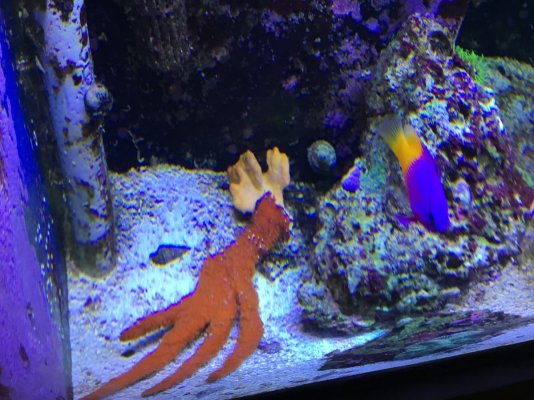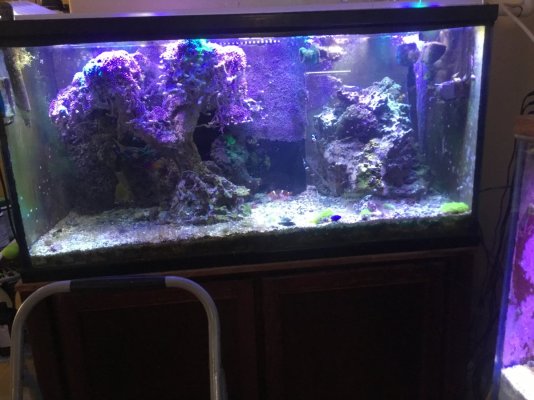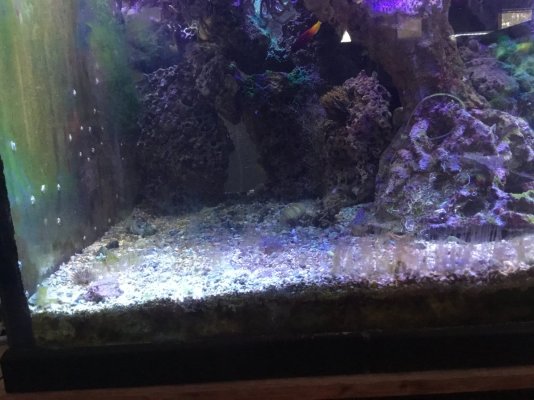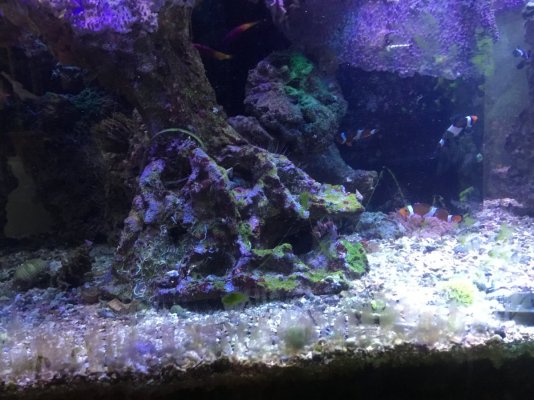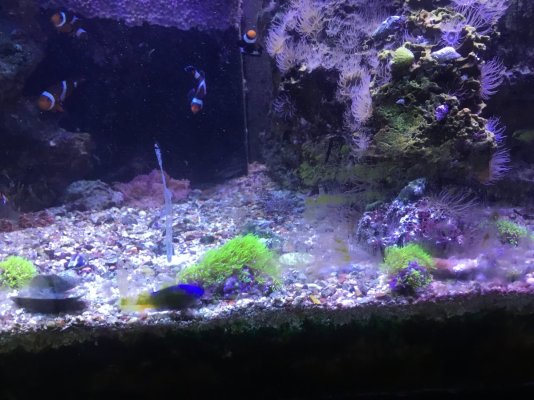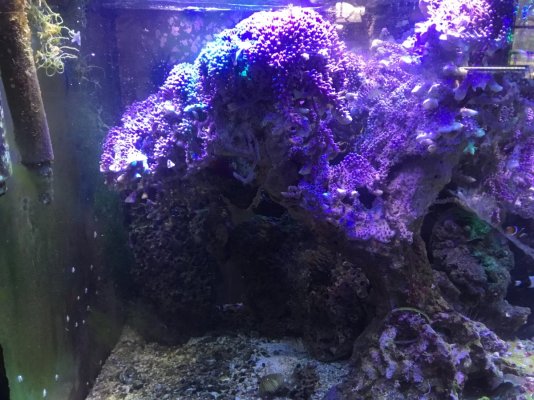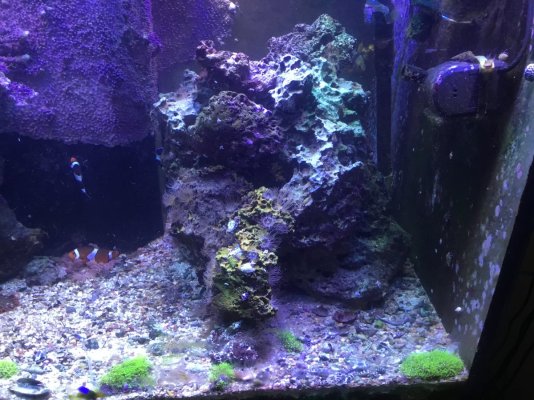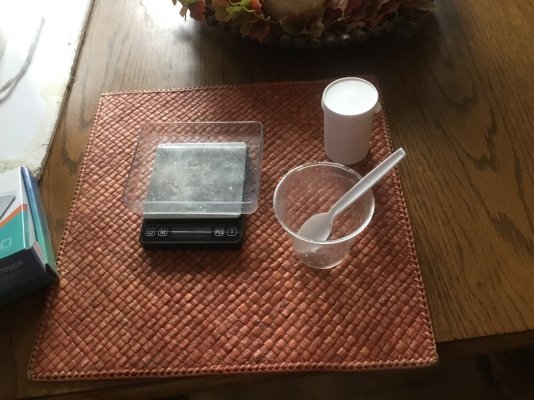While the pictures do not show it very well, overall there is less green algae to absorb light in the tank. Cleaning the glass helped us “see the light”.And I thought that was a big break thru, lol
Navigation
Install the app
How to install the app on iOS
Follow along with the video below to see how to install our site as a web app on your home screen.
Note: This feature may not be available in some browsers.
More options
You are using an out of date browser. It may not display this or other websites correctly.
You should upgrade or use an alternative browser.
You should upgrade or use an alternative browser.
The Bacterial “Rip Clean” Method
- Thread starter sixty_reefer
- Start date
- Tagged users None
So what biofloc did he use in the shrimp farms? I am just always skeptical when someone says they have discovered the best product to use but don't say what the product is. I am assuming he hasn't said what the best product is or else you would be using that?Not sure how to best answer the tone of your post.
With respect to perfect solutions, they don’t exist. There are trade offs with pros & cons.
With respect to biofloc in intensive shrimp farms, you should ask the doctor at his consulting business.
Dr. Tzachi Samocha
Edit
ORGANIZATIONS

Tooltip
+1 361-937-2268
+1 253-390-6081
[email protected]
AgriLife Research Mariculture Laboratory
4301 Waldron Rd.
Corpus Christi, TX 78418
USA
SPOKEN LANGUAGES
Visit Website
- English
Field of Focus
PS: Tzachi also speaks Hebrew. He was the tip of the spear in June 1967 as his tank brigade ended The 6 Day War. I only meant Tzachi once for a 2 hour tour of a shrimp farm. However, we are comrades in arms as I was a 19 year old Air Force crew chief on Puff the Magic Dragon patrolling Israel Jordan border in June of 1967.
- Physiology and Behavior
- Ecology
- Coastal Development
- Ecological Indicators
- Harmful Algal Blooms
- Invasive Species
- Pollution
- Sustainable Development
I wouldn't mind trying reef actif, but right now my experimental tank I am switching from zeostart to vinegar. And I haven't noticed any negative changes yet. I have doubts that the type of carbon we use will matter much for our purposes, however alchohol seems to be not as good in my experienceHas someone here switched over from vodka+vinegar to reef actif and witnesses practical differences, theory of goals or what it is supposed to do aside? If so, which ones?
@HomebroodExoticsSo what biofloc did he use in the shrimp farms? I am just always skeptical when someone says they have discovered the best product to use but don't say what the product is. I am assuming he hasn't said what the best product is or else you would be using that?
THERE ARE NO SECRET POLYMERS. Each system has separate characteristics that require different husbandry. If you read the links you can find details in peer reviewed research paper. As a consultant for intensive ship farms, he will research your requirements. He also has a book published with the information. At $50 for hard copy, I choose not to buy it.
PS I googled it and the price has gone up to $150.
Last edited:
I’m not talking about husbandry. I just want to know what carbon source he used. Why is that a difficult question?@HomebroodExotics
THERE ARE NO SECRET POLYMERS. Each system has separate characteristics that require different husbandry. If you read the links you can find details in peer reviewed research paper. As a consultant for intensive ship farms, he will research your requirements. He also has a book published with the information. At $50 for hard copy, I choose not to buy it.
Randy Holmes-Farley
Reef Chemist
View Badges
Staff member
Super Moderator
Excellence Award
Expert Contributor
Article Contributor
R2R Research
My Tank Thread
- Joined
- Sep 5, 2014
- Messages
- 67,349
- Reaction score
- 63,691
THERE ARE NO SECRET POLYMERS.
In a possibly unrelated note, there certainly are secret polymers. I've made hundreds, perhaps thousands of them. lol
Perhaps we need to go to the top shelf.I have doubts that the type of carbon we use will matter much for our purposes, however alchohol seems to be not as good in my experience
Randy Holmes-Farley
Reef Chemist
View Badges
Staff member
Super Moderator
Excellence Award
Expert Contributor
Article Contributor
R2R Research
My Tank Thread
- Joined
- Sep 5, 2014
- Messages
- 67,349
- Reaction score
- 63,691
I’m not talking about husbandry. I just want to know what carbon source he used. Why is that a difficult question?
I would not have much confidence that the needs of filtration in shrimp farm waste water have much in common with the needs inside a reef aquarium.
- Joined
- May 22, 2016
- Messages
- 6,546
- Reaction score
- 10,102
Right, the usefulness of carbon dosing as a measure against nuisance has been presented in numerous iterations Beuchat, Elegant Corals, Zeovit, dutch synthetic reefing, and on and on.Thank you for your work, I wasn’t aware that you had done this.
this test seems to go in line with how dinoflagellates are eradicate in Beuchat article and other methods that use high carbon dosing to fully deplete nitrogen.
What gets re-invented are the many explanations for why it works "makes the bacteria eat the bad guys" and so on. The simplest case is that these measures can work with nutrient limitation.
That was the point of where I ended up after the Elegant Corals method. Slamming a big carbon dose will deplete nutrients. Nuisances disappear and I could measure their signs of N stress from photopigments as they faded.
No need for fancier explanations. No need to conclude that the microbubbling or the special bottles of bacteria advocated in that method were crucial.
Right, a sweet spot that leaves a little NO3 behind is generally accepted as a better idea.The only thing I normally don’t agree is with the depletion of nitrates, this due to if a treatment was to be implemented in a system with many corals the risk of coral bleaching becomes very high due to their need for nitrogen also.
Are you saying this carbon source would leave NO3 and PO4 available when others wouldn't? Or are you just saying in the right doses a carbon source won't pull NO3 & PO4 to zero?I also believe that the ability of actif to target this specific nutrients instead of nitrates and phosphates a advantage at the moment
Has someone here switched over from vodka+vinegar to reef actif and witnesses practical differences, theory of goals or what it is supposed to do aside? If so, which ones?
To me these are very interesting questions, maybe even important ones for the hobby.I wouldn't mind trying reef actif, but right now my experimental tank I am switching from zeostart to vinegar. And I haven't noticed any negative changes yet. I have doubts that the type of carbon we use will matter much for our purposes, however alchohol seems to be not as good in my experience
My opinion is that the type of carbon source can matter a lot - but my evidence is just as thin and anecdotal as everyone else's.
I think different carbon sources feed different things and result in captured nutrients that take different pathways: particulates in water, biofilm on surfaces, skimmable aggregates, extracellular gels, etc.
Seven years ago, when I toured shrimp farm for 2 hours, I had no idea about carbon dosing or biofloc.I’m not talking about husbandry. I just want to know what carbon source he used. Why is that a difficult question?
So I never asked him AND to be blunt, I don’t care that you have chosen not to look at links provided to research information you desire to know.
Last edited:
I find shrimp farm waste management fascinating due to tight tolerances required to prevent colony crashes, I would vote shrimp farm management as tougher than fish farm management based on what I’m seeing. Fish farming seems a lot like cattle farming and marine shrimp farming very nuanced and prone to colony crashes even in well-performing systems.
What I think would be awesome to know is which carbon source would be better to utilize for a specific Dino, I think all of the troubles come down to the wild wild west of bacteria and know how to influence the ones you want vs the ones you don't really could help moving forward. I know the philosophy of keeping nutrients up etc, but it would be nice to find away to just influence things a certain direction with light carbon dosing etc..Right, the usefulness of carbon dosing as a measure against nuisance has been presented in numerous iterations Beuchat, Elegant Corals, Zeovit, dutch synthetic reefing, and on and on.
What gets re-invented are the many explanations for why it works "makes the bacteria eat the bad guys" and so on. The simplest case is that these measures can work with nutrient limitation.
That was the point of where I ended up after the Elegant Corals method. Slamming a big carbon dose will deplete nutrients. Nuisances disappear and I could measure their signs of N stress from photopigments as they faded.
No need for fancier explanations. No need to conclude that the microbubbling or the special bottles of bacteria advocated in that method were crucial.
Right, a sweet spot that leaves a little NO3 behind is generally accepted as a better idea.
Are you saying this carbon source would leave NO3 and PO4 available when others wouldn't? Or are you just saying in the right doses a carbon source won't pull NO3 & PO4 to zero?
To me these are very interesting questions, maybe even important ones for the hobby.
My opinion is that the type of carbon source can matter a lot - but my evidence is just as thin and anecdotal as everyone else's.
I think different carbon sources feed different things and result in captured nutrients that take different pathways: particulates in water, biofilm on surfaces, skimmable aggregates, extracellular gels, etc.
While moving rock to take better picture of flame scallop, I exposed a small ugly black cyno patch. I consider this a micro ecosystem that is soon vacuumed to waste. At 3 hours from end of photo period, light diatom dusting is decreasing.Please keep updating this pictures and any other observations you see whether they are positive or negative.
Attachments
sixty_reefer
5000 Club Member
View BadgesArticle Contributor
UK Reef Club Member
Hospitality Award
R2R Research
Are you saying this carbon source would leave NO3 and PO4 available when others wouldn't? Or are you just saying in the right doses a carbon source won't pull NO3 & PO4 to zero?
Yea that’s correct, even with building up the dosage to twice the recommended dose 7 days a week the the nitrates and phosphates stayed stable.
In my system I keep a dosing unit that adds nitrogen twice a day to keep my algaes alive, every time I run out, the red algaes start to go dark brown and melt.
the only thing I noticed is that if overdosed during light on the system gets full of gas bubbles (possibly o2) as only happens at lights on, i Normally dose it at lights out to avoid that.
I have played with many types of organic carbon before and noting seems like this one, I find it really safe for all kind of experience a aquarists may have due to being so complicated to mess with it. The only time I’ve observed it lowering nitrates and phosphates was on a controlled induced bloom in a experimental tank were I dosed the recommended dosage to a 25 gallon on a 5 gallon system.
It’s unfortunate that there isn’t any other product similar to actif on the market to be able to compare it with although in my mind it crossed a few times to try and compare it to tapioca (complex carbohydrate) to evaluate if the complexity of the carbohydrate could be key in only be able to be metabolised by certain types of bacteria. I don’t have access to aquabiomics testing the comparison could only be visual and nitrates and phosphates comparison.
sixty_reefer
5000 Club Member
View BadgesArticle Contributor
UK Reef Club Member
Hospitality Award
R2R Research
I would be tempted to ask you to not clean that rock as a way to evaluate if the bacteria promoted can eventually outcompete the Cyanobacteria, although it’s your system and your decision.While moving rock to take better picture of flame scallop, I exposed a small ugly black cyno patch. I consider this a micro ecosystem that is soon vacuumed to waste. At 3 hours from end of photo period, light diatom dusting is decreasing.
No worries. I will leave IT there but will move ornamental sponges and toothbrush stuff from feet of sponges. This would allow improved circulation for activated bacteria.I would be tempted to ask you to not clean that rock as a way to evaluate if the bacteria promoted can eventually outcompete the Cyanobacteria, although it’s your system and your decision.
Also, don’t ask about N & P numbers. I have unopened test kits that expired 10 years ago. By the end of this test, I will send water to be tested for household minerals and the heavy metals of zinc & copper. Standard test for metals cost $10 each with a sensitivity down to 0.1 ppm.
If I only require standard reef parameters, LFS charges $8
Last edited:
“Wild wild west of bacteria”. Cute, but to research scientist it’s job security.What I think would be awesome to know is which carbon source would be better to utilize for a specific Dino, I think all of the troubles come down to the wild wild west of bacteria and know how to influence the ones you want vs the ones you don't really could help moving forward. I know the philosophy of keeping nutrients up etc, but it would be nice to find away to just influence things a certain direction with light carbon dosing etc..
While @Dana Riddle had started using very high doses of phyto to manage his home aquarium, then a hurricane and a death in family took him of point, my goal is five 1G containers, Dana had a 55G continuous phytoplankton culture.
I have read srveral Dana Ridde articles on Advanced Aquaria about coral nutrition. I liked this statement the best: Photosynthesis is where the inorganic & the organic world come together with carbon dioxide dissolving readily in water to transform alkalinity into glucose, which is carbon for the reef.
@Tom Bishop
I think live phytopkankton is your best carbon source to dose.
Last edited:
First picture shows black patch. What was brushed off red tree sponge was growing in a sheet.I would be tempted to ask you to not clean that rock as a way to evaluate if the bacteria promoted can eventually outcompete the Cyanobacteria, although it’s your system and your decision.
Second picture, orange elephant ear sponge at top had red/maroon Cynobacteria when I brushed it off a micro starfish fled the toothbrush.
Third picture shows slight emerging maroon cyno on bottom orange elephant ear sponge. I will wait and observe cyno development on this sponge.
NOTE: This is about 24 hours since third 75% dose of biofloc.
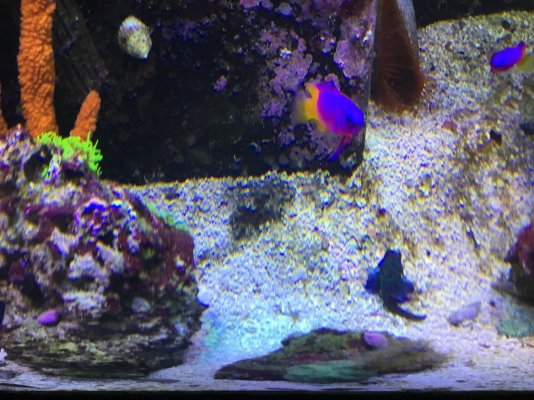
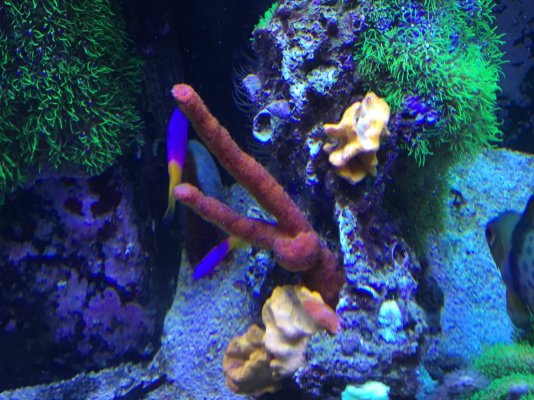
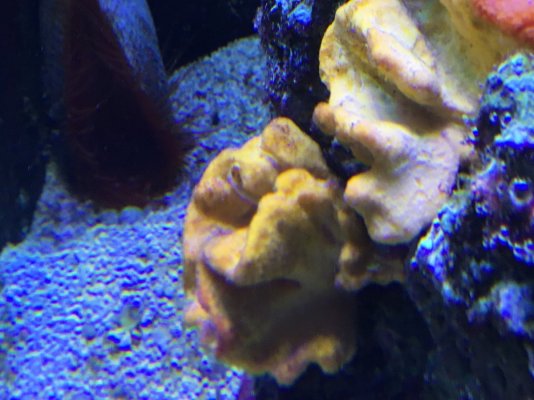
Last edited:
Twenty four hours ago the third 100% full dose of 3 grams into 120G display with 40G cryptic refugium. Lights on for 30 minutes. The color rendition of this display tank is 10K. Overall I see improvement in decreasing green algae on everything and an overall increase in light. If I had a PAR meter, I could give hard numbers
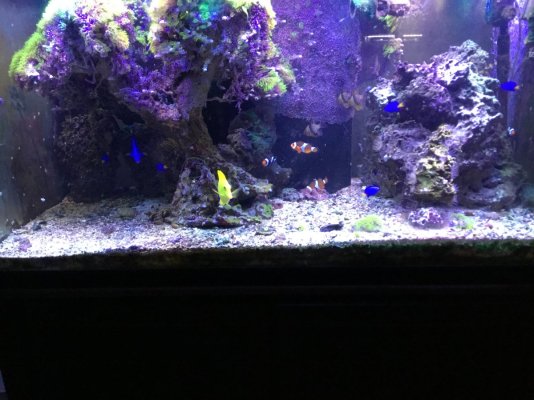
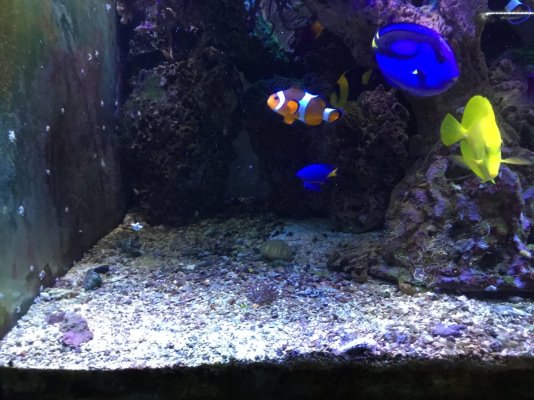
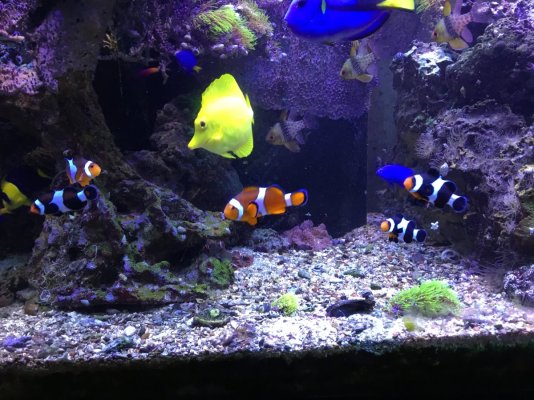
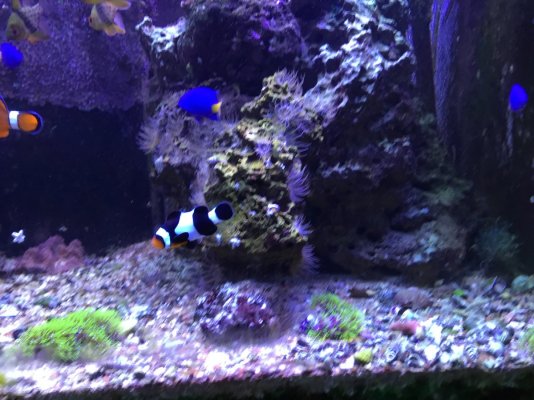
Last edited:
- Joined
- Aug 20, 2016
- Messages
- 523
- Reaction score
- 609
Once the heterotrophic bacteria population helps control the competition of ammonia to be used by nuisances (cyano, dino); what is the next step in how we can allow corals to uptake ammonia for faster growth?I’m proposing to use biofloc technology that uses carbohydrates to stimulate the growth of heterotrophic bacteria
( Pseudoalteromonadaceae, Bacillaceae amongst others) responsible for reducing organic matter in aquaria, this are the common sources of inorganic nitrogen (ammonia) that can cause many nuisances
sixty_reefer
5000 Club Member
View BadgesArticle Contributor
UK Reef Club Member
Hospitality Award
R2R Research
Once everything is back under control you have many options to get the corals growing again.Once the heterotrophic bacteria population helps control the competition of ammonia to be used by nuisances (cyano, dino); what is the next step in how we can allow corals to uptake ammonia for faster growth?
1. stop using actif and look at flow, filtration including protein skimmer to se if they can be improved so that the same won’t happen again. Keep nitrates and phosphates detectable at all times.
2. Keep using actif for the benefit that it brings and add a supplement that contains organic and inorganic nutrients. Actif can be used simultaneously with bacto balance if you prefer TM products I like ATI nutrition N as it’s only beneficial organic and inorganic nutrients (no carbon source in it) this allows to control how much you want im the system as you are able to increase it and decrease it like any other parameter.
There is other options, some are better than others in my experience.
this are just a few options there is many ways to achieve growth in reef aquaria that just require a little planing.
Similar threads
- Replies
- 2
- Views
- 68
New Posts
-
What’s a fish or invert that has / had a surprisingly long lifespan for you?
- Latest: Townes_Van_Camp
-
-






